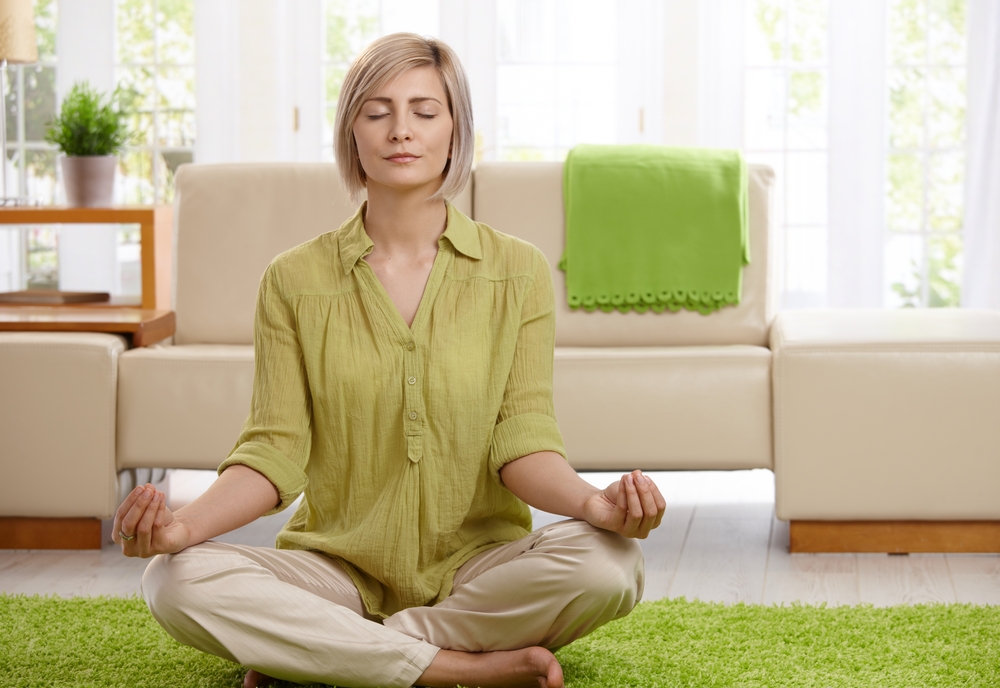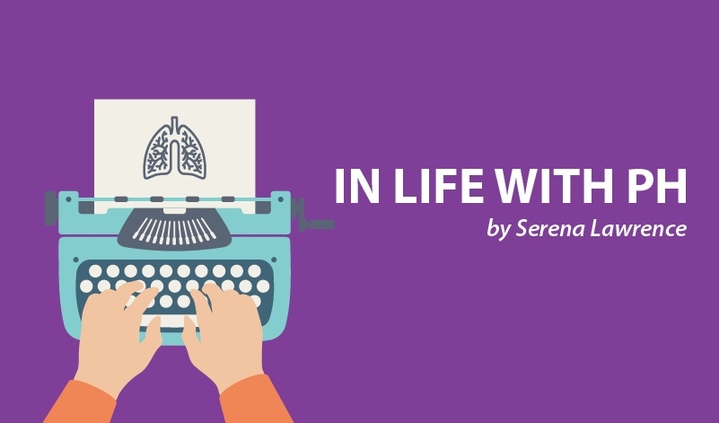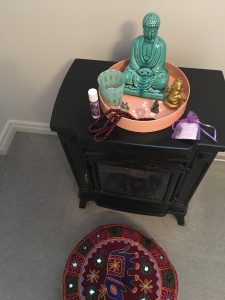Meditation 101: A Guide for Beginners

My column last week, Meditation to Manage Stress, discussed why I started to practice meditation and mindfulness after being diagnosed with pulmonary hypertension. A naturopath recommended it after my diagnosis and, although hesitant at first, I researched the benefits and decided to try it out.
Practicing meditation was very difficult at first. Truthfully, I still have days where I find it hard. The days I need it the most are the days that I am least motivated to set the time aside. Some meditations are so challenging that I have found myself crying through them, but perhaps this was a way of letting out emotions I was avoiding dealing with.
I am not sharing this to discourage anyone, but rather to acknowledge that meditation can be challenging. If meditation is something you want to incorporate into your lifestyle, don’t be discouraged if you find it difficult at first. It does become easier. Even on the days I am least able to practice mindfulness well, I am still glad to take the time to unplug from the world, restore, and connect to myself.
Here are several types of meditation that I enjoy practicing, along with some tips you may find helpful.
Types of meditation
It is important that you find the right practice for you. Finding one that is comfortable to you will help make it easier to want to practice every day. Making time to meditate everyday, and taking the time to disconnect from the world and connect to yourself, is one of the ultimate goals of mindfulness.
Because there are dozens of different types of meditation, I will only be explaining three of my favorite. If none of these work well for you, you may want to look into some of the other practices used.
Guided Meditation
I found that guided meditation was really helpful when I first started. In this, you listen to someone else’s voice to help you. Think of it like having a coach or teacher! There are lots of great guided meditations out there that can help prepare for the day, let go of stress, get your mind ready for sleep, and take you through visualization practices, such as dealing with pain or illness. Many guided meditations are available online and can be found in app stores, music stores, and for free on different websites and YouTube.
Mindfulness of Breathing
This technique, often referred to as Zen, focuses on your breath. By focusing on inhalation and exhalation, you concentrate on the present moment. Another way to help focus on your breath is by counting each breath you take, up to the count of 10. Stay focused on your breath, count one for an inhale, two for exhale, three for inhale, and so on, up to your 10th breath. When you reach 10, simply start over again. If you lose count, just start over again at one.
Mantra
Mantra meditation uses a mantra or a series of words in Sanskrit to help keep focus during meditation practice. In modern practice, an affirmation is sometimes used as well. One of the most common mantra’s used is “om,” which is said to be the sound of the earth.
Tips for Meditation
Start slow and increase
Start meditating for five minutes everyday, and increase the time every three to seven days. Try to work your way up to an allocated set amount of time that works well for you. You can also divide your times. (For example, you may want to meditate for 10 minutes in the morning and 10 minutes before bed, if you find it helps you start and finish your day.) I meditate between 15-20 minutes a day, daily, but you can certainly do so for longer and more often! It is all about finding what feels right for you.
Be sure to set a timer for the allocated time you wish to meditate. This way you will not have to constantly look at the clock, and will be able to truly focus on mindfulness.
Do not disturb
If you live with other people, you may want to alert everyone that you will be meditating so they do not disturb you. I let my family know how long I will be meditating for, and often leave a little sign on my door that reads, “meditating.”
Special space
Create a special space for where you meditate. I have a meditation altar, which I find helpful to be in front of while sitting on a meditation cushion. What you choose to put at your altar is completely up to you. You will want to pick symbols and objects that you find soothing and joyful. You can include special rocks, crystals, statues, signs with affirmations, candles (I use a battery-powered fake candle!) and pictures. Mine is on a small fireplace in my room, and eye level when I sit in front of it.
Set the mood
What helps your mind get in the mood to meditate? If it’s safe for you to use scents, there are balms and oils that you can rub on your temples before meditation to help ease your mind. Candles, even battery-powered, can also help set the mood. You may want to ensure that you are wearing comfortable pants as you will be sitting for at least 10 minutes. If you are not using a guided meditation, you may want to play some ambient music made specifically for meditation.
What kind of meditation do you like to practice?
Note: Pulmonary Hypertension News is strictly a news and information website about the disease. It does not provide medical advice, diagnosis, or treatment. This content is not intended to be a substitute for professional medical advice, diagnosis, or treatment. Always seek the advice of your physician or other qualified health provider with any questions you may have regarding a medical condition. Never disregard professional medical advice or delay in seeking it because of something you have read on this website. The opinions expressed in this column are not those of Pulmonary Hypertension News or its parent company, Bionews Services, and are intended to spark discussion about issues pertaining to pulmonary hypertension.










Janet
I'm so sorry to hear that you have difficulty meditating sometimes. The Transcendental Meditation technique is not, actually, just any mantra meditation. It is a very specific technique taught throughout the world by certified teachers in a systematic way. It is the most scientifically verified program of meditation, with more than 380 peer reviewed published studies backing up the benefits. The beautiful thing is that it is also effortless--to the point where it is learned by even children with severe symptoms of ADHD and veterans with PTSD. It is easy to learn and to do and the results are both immediate and cumulative.
Serena Lawrence
Thank you for the additional information about meditation.
Lawson English
You might want to check what the American Heart Association says about TM vs other forms of meditation (mantra or mindfulness or anything else with a body of research that they could evaluate):
http://hyper.ahajournals.org/content/hypertensionaha/early/2013/04/22/HYP.0b013e318293645f.full.pdf
"Summary and Clinical Recommendations"
"The overall evidence supports that TM modestly lowers BP. It is not certain whether it is truly superior to other meditation techniques in terms of BP lowering because there are few head-to-head studies. As a result of the paucity of data, we are unable to recommend a specific method of practice when TM is used for the treatment of high BP. However, TM (or meditation techniques in general) does not appear to pose significant health risks. Additional and higher-quality studies are required to provide conclusions on the BP-lowering efficacy of meditation forms other than TM."
"The writing group conferred to TM a Class IIB, Level of Evidence B recommendation in regard to BP-lowering efficacy. TM may be considered in clinical practice to lower BP. Because of many negative studies or mixed results and a paucity of available trials, all other meditation techniques (including MBSR) received a Class III, no benefit, Level of Evidence Crecommendation. Thus, other meditation techniques are not recommended in clinical practice to lower BP at this time." [page 6]
Note that the most common form of "mantra meditation," Benson's Relaxation Response was reviewed on page 8, as part of "other relaxation techniques," and found to be to inconsistent to receive a passing grade, while "focused attention," including "mantra meditation," was viewed as not making the grade either.
The only multi-year, longitudinal study on mindfulness that examines its effects on blood pressure reported that mindfulness had BP-lowering effects during the first year, but that those effects did not show up in the 2-year and 3-year followup tests: https://www.ncbi.nlm.nih.gov/pubmed/24798861
The difference between TM and other practices such as mindfulness and focused attention pratices is that the teaching of TM is always following a precise teaching method developed by a single person who insisted on absolutely precise performance of said method by people who rehearse for 5 months, in-residence, while mindfulness and focused attention research is done on people practicing techniques taught in a myriad of different ways, including from books and audio tapes.
The result is that TM practitioners are helped to develop a simple intuition about relaxing meditation practice that tends to stay with them for the rest of their lives, while mindfulness and focused attention are taught more haphazardly. TMers also are encouraged to return to the nearest local TM center for the rest of their lives for free followup to refresh that intuition while there's no real concept of followup, free or otherwise, with most mindfulness and focused attention practices.
Finally, that simple intuition about TM, combined with the lifetime followup, means that TM starts out a simple intuitive relaxation practice and remains a simple intuitive relaxation practice, whether one has been practicing a few days, weeks, months, years or even decades, while research shows that mindfulness and concentration change from simple relaxation to attentional training as practice continues. Because of that, it shouldn't be surprising that TM's benefits continue to manifest and accrue in the same way throughout the life of the TMer, while mindfulness and focused attention benefits change over time, as this recent research review points out:
https://www.ncbi.nlm.nih.gov/pmc/articles/PMC4054695/
Contrast that last with this research review of the long-term effects of TM practice: https://www.researchgate.net/profile/Frederick_Travis/publication/261181813_Transcendental_experiences_during_meditation_practice/links/5487b1a00cf2ef34478ecd44.pdf
TM is quite different than other practices, although ironically, what makes TM special is that it is NOT special: it merely enhances normal relaxation so that the brain becomes more and more accustomed to being in this style of relaxation even outside of meditation. Since mindfulness and focused attention literally change AWAY from being relaxation, the difference between TM and other practices grows as experience in meditation does.
Enrico Galard
Excellent post on Benefits of Meditation. I am very happy to read. Thanks for providing great information.